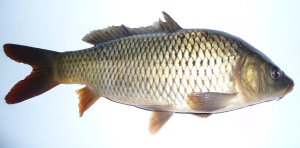[An Archaeologist’s Guide to British Species] #80: Carp, Common
In 2023, I am continuing to blog an A-Z compendium of human interactions with species in the British landscape. A list of references for information used in this series can be found here. An index of species covered so far can be found here.

Common carp, image by George Chernilevsky – Own work (CC BY-SA 3.0)
Carp, Common
Cyprinus carpio Linneaus, 1758
A freshwater fish, native to Asia as far west as the Black Sea, but which was introduced to Britain from the medieval period, having begun to be introduced westwards across the continent during the Roman period. They are found in ponds, lakes, canals and slow-moving rivers, where they turn up the bed looking for food. They are tolerant of low oxygen levels, but are limited by a minimum spawning temperature of 18°C. Common carp commonly grow to 40-50cms, but larger specimens can occur. Carp have two characteristic pairs of barbels on their upper lip. Forms completely covered in scales are sometimes known as king carp, those with only a single line of scales as mirror carp, and those lacking scales as leather carp. They can live around 15 years in the wild, and over 40 in captivity. They were once a common food fish, and were stocked in ponds, but fell out of favour in Britain. There is a record of carp from a Roman site in Lincoln, however this identification has been questioned, and it is otherwise unknown from Britain before the 13th century.